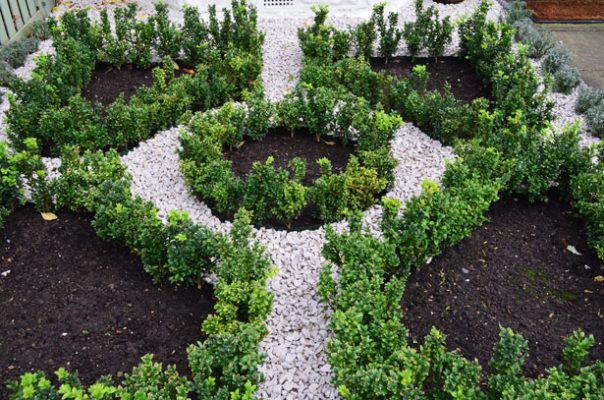
There’s much to be said for using garden gravel, whether the intent is to reduce the amount of maintenance required in the garden, to cut down on watering requirements, or simply for the aesthetic appeal gravel can bring. Although the benefits can be substantial, putting in garden gravel can also be a lot of work, even more so if you don’t get it right the first time. Moving gravel about is one thing, moving both dirt and gravel, and trying not to get them mixed in with one another is a different matter.
Garden Gravel Sizes
Gravel is usually defined as small rocks, whether they are crushed or remain in their naturally rounded shapes. The size of the rocks making up garden gravel usually varies from 1/8 inch, which is more like coarse sand, up to 1-1/2 inches. Gravel which is 1/4 to 3/8 inch in size is often referred to as pea gravel. Rocks larger than 1-1/2 inches in size are usually referred to like rock or stones, not gravel. The size of gravel isn’t determined by law, but it’s nice to know what to ask for, or what you can expect to have delivered.
What do People Use Garden Gravel for?
Mostly for creating pathways in and around the yard or garden. In some cases, gravel is used as a replacement for a lawn, the benefits were not having to mow or water where the grass once was. Garden gravel is also used as a mulch for plants and for borders. In many gardens in the American Southwest, where the plants found in the garden are succulents or cacti, gravel is used to mulch and cover the entire garden, and is often much more attractive than dirt, or even bark would be in similar circumstances.
Read More: Garden Makeover Ideas
Crushed Gravel is Usually Best for Pathways
Using crushed gravel avoids the feeling of walking on ball bearings, and also avoids scattering the gravel into places it isn’t wanted when foot traffic becomes heavy. Pea gravel will usually work well for paths also, as it is too small to scatter easily, and does not produce a ball-bearing feeling when walking upon it. Gravel 3/8 inch and under is most often the size of choice for mulching plants, but the size chosen often depends upon the plant.
Figure Out How Much Of What
The best way to plan how to use garden gravel is to start with pencil paper and a tape measure. Draw up a plan showing where you want the gravel to be placed, what size garden gravel you want, and how deep it should be. That way you can calculate how many square yards you will need to have delivered. Look for a local source, as gravel is heavy, and delivery of just a few yards over a long distance can be expensive.
Matters can become complicated if there are several sizes of gravel you want. In cases like that, owning or borrowing a pickup truck can be a plus. A standard pickup can usually carry from 1/2 to 3/4 of a yard of gravel safely. Be careful not to overdo it, if you spill gravel on the roadway while driving, you could find yourself in some trouble.
Rocks Have A Place As Well
You needn’t restrict yourself solely to garden gravel. Consider larger stones as well, river rock can be particularly attractive in some places, and larger flat rocks make good sense in others. Larger stones are often used as borders or boundaries for areas covered with a gravel garden. If you enjoy raking, which is how the look of garden gravel is usually maintained, consider putting in a traditional Japanese garden, where small gravel, or pea gravel, is used as the ground cover, and the different and changing patterns that raking makes become part and parcel of the garden’s design and look.
Whatever you do though, plan first, and look around for examples to follow. In that way, your initial layout is more apt to end up being your permanent layout, and you won’t be spending time moving yards of dirt and gravel back and forth.
How would you Rate Gravel Driveway and Crushed Stone as a Driveway Material?
Pros of Gravel Driveways:
- Cost.
- No frost heaves in cold climates.
- No “repair,” since there’s nothing to break.
- Likewise, no “maintenance,” since there’s nothing to maintain.
Cons of Gravel Driveways:
- Snow-removal is difficult.
- Ruts form relatively quickly, marring the appearance.
- Dirty.
Most of the pros and cons discussed on this page also apply to other driveways similar to gravel driveways; for instance, driveways composed of crushed stones, crushed seashells or cinder (although none of these are dirty, and all are more attractive than gravel). By “gravel” I mean coarse sand that has small stones mixed into it.
Because gravel driveways are inexpensive, they are often the driveway of choice in rural areas where “keeping up with the Joneses” is not an issue. You’ll need to add more gravel periodically as ruts form and gravel is lost, but that’s easy enough: you just have another load of gravel dumped and spread. You don’t need to worry about a base with gravel driveways, so neither do you need to fret over the expertise of the individual “installing” your gravel driveway. Gravel driveways also mean no repair or maintenance jobs for you. There will be no sealing, no patching, no cleaning because there isn’t any surface that can be damaged or stained.
But gravel driveways aren’t the most attractive of driveways, although they may work fine aesthetically if you’re striving for a “folksy” look in your landscape design. Gravel driveways are a mixed bag in Northern climes. On the one hand, they provide no surface for the freezing/thawing cycle to work on, so they don’t suffer from frost heaves. But gravel driveways make snow removal difficult for the same reason: namely, the lack of a flat, clean surface over which to run a plow or scrape a shovel.
How to lay Gravel in the Small Garden
We suggest you step by step how to lay gravel garden onto your small garden, so get your spade, garden rack, and gravel out and start laying some garden area. You should plan carefully and have all the required materials and tools before you start work.
In the case of the small garden, gravels are sold in plastic sacks in garden stores if possible obtain small samples of those you think might be appropriate and try them out in a small area in your own garden.
1/ First, marking out the shape with a rope or hosepipe where the outline should be. Many people design a gravel garden area with oval-shaped beds, which are ideal for small gardens.
2/ Dig out a path’s shape around the rope or hosepipe by a spade. Excavate the area to a depth of about 2 inches. If you make the gravel garden deeper that means more soil moving and take some extra cost.
3/ Lay down the landscape fabric to prevent deep-rooted weeds from appearing, overlapping the strips by about 2 inches.
4/ Install and tap down the edging. Barrow the gravel garden into position, then distribute it over the surface, making sure it is about 2 inches thick. Use a rake to level the surface, and then consolidate it by walking over it or rolling it. Re-rack if necessary.
5/ Try finishing with adding a few stones, containers, and ornaments to make a gravel floor ideal for a small garden.









